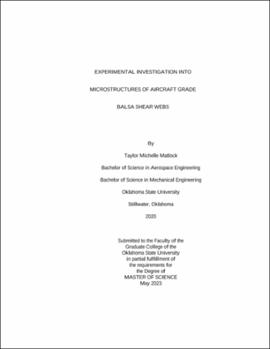| dc.contributor.advisor | Arena, Andy | |
| dc.contributor.author | Matlock, Taylor Michelle | |
| dc.date.accessioned | 2023-08-25T20:06:17Z | |
| dc.date.available | 2023-08-25T20:06:17Z | |
| dc.date.issued | 2023-05 | |
| dc.identifier.uri | https://hdl.handle.net/11244/338940 | |
| dc.description.abstract | Unmanned aerial vehicles (UAVs) typically rely on balsa wood as the primary material for their aircraft structure. While previous research at Oklahoma State University had established basic material properties of aircraft grade balsa wood, it has also yielded some counterintuitive findings. Specifically, thicker, higher density balsa wood was observed to have a lower force to failure than the thinner, less dense balsa wood. Furthermore, it was hypothesized that this was due to an increase in microstructural defects as thickness increased [1]. This prompted an extensive investigation into balsa wood failure characteristics, with a particular focus on the possible correlation between microstructural defects and the unexpected failure of thicker, more dense balsa wood. To test this hypothesis, four experiments were conducted. The first two experiments involved tensile tests with the force applied perpendicular to the grain direction. The first experiment resulted in trends like the previously mentioned research. However, the second experiments, conducted with balsa wood sourced from a distributor with more rigorous selection standards, showed that ultimate tensile strength increased proportionally to density and remains within the bounds of found uncertainty until reaching the “heavy” density classification (greater than 14 lb/ft³). The third experiment focused on tensile testing with the force applied parallel to the grain direction to obtain data for different plane directions, but this test set was inconclusive due to the load cell of the testing apparatus having a maximum loading of 1000N. Finally, visual experimentation was performed. This revealed that increasing the density of balsa wood correlates to an increase in the number and size of ray cells which contributes to the increase in the modulus of elasticity and misalignment of fibers of the cell. This was ultimately determined to be the cause of the ultimate failure at higher density for thicker balsa wood. In conclusion, heavy and extra heavy density of balsa wood were found to be unsuitable for use aircraft shear webs. Additionally, the groundwork for visual inspection of balsa wood was laid through these experiments. | |
| dc.format | application/pdf | |
| dc.language | en_US | |
| dc.rights | Copyright is held by the author who has granted the Oklahoma State University Library the non-exclusive right to share this material in its institutional repository. Contact Digital Library Services at lib-dls@okstate.edu or 405-744-9161 for the permission policy on the use, reproduction or distribution of this material. | |
| dc.title | Experimental investigation into microstructures of aircraft grade balsa shear webs | |
| dc.contributor.committeeMember | Conner, Joseph | |
| dc.contributor.committeeMember | Azoug, Aurelie | |
| osu.filename | matlock_okstate_0664m_18117.pdf | |
| osu.accesstype | Open Access | |
| dc.type.genre | Thesis | |
| dc.type.material | Text | |
| thesis.degree.discipline | Mechanical and Aerospace Engineering | |
| thesis.degree.grantor | Oklahoma State University | |
